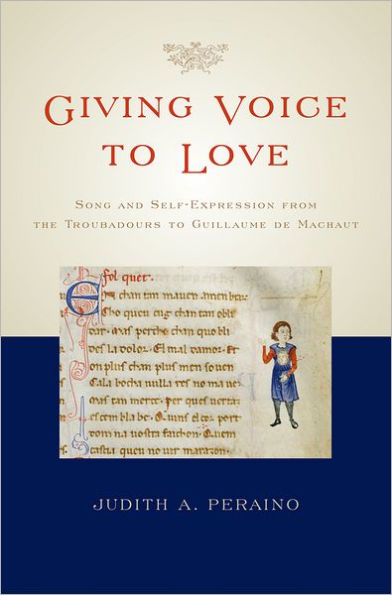Giving Voice to Love: Song and Self-Expression from the Troubadours to Guillaume de Machaut
Grafting musicology and literary studies together in an unprecedented manner, Giving Voice to Love: Song and Self-Expression from the Troubadours to Guillaume de Machaut investigates French and Occitan "courtly love" songs from the twelfth to fourteenth centuries and explores the paradoxical relationship of music and self-expression in the Middle Ages. While these love songs conceived and expressed the autonomous subject - the lyric "I" represented by a single line of melody - they also engaged highly conventional musical and poetic language, and required performers and scribes for their transmission. This paradox was understood by the poets and became the basis for irony, parody, and intertextual referencing, which instilled the lyrics with a characteristic self-consciousness that reflected the unstable conditions for self-expression.
Author Judith Peraino reveals similar operations at work in musical settings. Examining moments where voice, melody, rhythm, form, and genre come dramatically to the fore and seem to comment on music itself, Giving Voice to Love strives not only to hear self-expression in these love songs, but to understand how musical elements give voice to the complex issues of self and subjectivity encoded in medieval love.
Through its approach to the exploration of "courtly love" songs, Giving Voice to Love serves as a model for methodological integration and provides musicologists, literary scholars and medieval historians with a common analytical ground.
1101998628
Author Judith Peraino reveals similar operations at work in musical settings. Examining moments where voice, melody, rhythm, form, and genre come dramatically to the fore and seem to comment on music itself, Giving Voice to Love strives not only to hear self-expression in these love songs, but to understand how musical elements give voice to the complex issues of self and subjectivity encoded in medieval love.
Through its approach to the exploration of "courtly love" songs, Giving Voice to Love serves as a model for methodological integration and provides musicologists, literary scholars and medieval historians with a common analytical ground.
Giving Voice to Love: Song and Self-Expression from the Troubadours to Guillaume de Machaut
Grafting musicology and literary studies together in an unprecedented manner, Giving Voice to Love: Song and Self-Expression from the Troubadours to Guillaume de Machaut investigates French and Occitan "courtly love" songs from the twelfth to fourteenth centuries and explores the paradoxical relationship of music and self-expression in the Middle Ages. While these love songs conceived and expressed the autonomous subject - the lyric "I" represented by a single line of melody - they also engaged highly conventional musical and poetic language, and required performers and scribes for their transmission. This paradox was understood by the poets and became the basis for irony, parody, and intertextual referencing, which instilled the lyrics with a characteristic self-consciousness that reflected the unstable conditions for self-expression.
Author Judith Peraino reveals similar operations at work in musical settings. Examining moments where voice, melody, rhythm, form, and genre come dramatically to the fore and seem to comment on music itself, Giving Voice to Love strives not only to hear self-expression in these love songs, but to understand how musical elements give voice to the complex issues of self and subjectivity encoded in medieval love.
Through its approach to the exploration of "courtly love" songs, Giving Voice to Love serves as a model for methodological integration and provides musicologists, literary scholars and medieval historians with a common analytical ground.
Author Judith Peraino reveals similar operations at work in musical settings. Examining moments where voice, melody, rhythm, form, and genre come dramatically to the fore and seem to comment on music itself, Giving Voice to Love strives not only to hear self-expression in these love songs, but to understand how musical elements give voice to the complex issues of self and subjectivity encoded in medieval love.
Through its approach to the exploration of "courtly love" songs, Giving Voice to Love serves as a model for methodological integration and provides musicologists, literary scholars and medieval historians with a common analytical ground.
89.0
Out Of Stock
5
1

Giving Voice to Love: Song and Self-Expression from the Troubadours to Guillaume de Machaut
384
Giving Voice to Love: Song and Self-Expression from the Troubadours to Guillaume de Machaut
384
89.0
Out Of Stock

Product Details
| ISBN-13: | 9780199757244 |
|---|---|
| Publisher: | Oxford University Press |
| Publication date: | 11/28/2011 |
| Pages: | 384 |
| Product dimensions: | 6.30(w) x 9.40(h) x 1.20(d) |
About the Author
From the B&N Reads Blog
